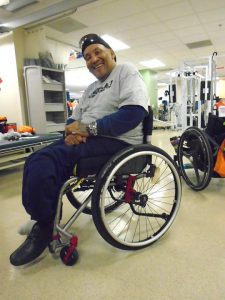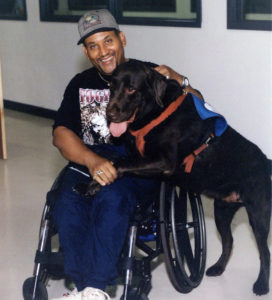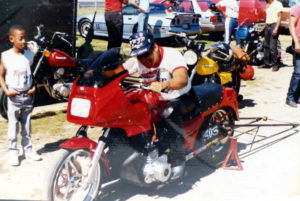If you’re new to SPORTS ‘N SPOKES, you most likely don’t know about the S’NS mascot, Ace.
Ace was a fictional wheelchair user seen lugging around a variety of sports equipment. From wheelchair basketball to golf to bowling, Ace had done it all.
His mission: Encourage other people with spinal-cord injuries to give accessible sports a try and, of course, encourage folks to buy an S’NS T-shirt.
Ace first appeared in a full-page ad in May 1975 and later showed up in September 1982 with an updated look and some additional sports equipment. He became the official mascot of SPORTS ‘N SPOKES and was used on T-shirts and calendars.
The Real Ace
If Ace was a real person, he’d be Detroit, Mich., resident, Larry Dilworth Jr. He’s played wheelchair basketball, jumped out of a perfectly good airplane and went scuba diving, just to name a few. Dilworth says he’s tried it all.
“I played wheelchair basketball with the Detroit Pistons in the ’80s,” says Dilworth. “I wasn’t as good at basketball unless the media was out there. Then I was all net.”
Dilworth got involved with the Pistons through the help of a local organization named the Detroit Wheelchair Athletics Association. Since his basketball skills weren’t up to par, Dilworth found other ways to contribute and help promote adaptive sports.
“I did a lot of PR for them and put together halftime shows that included scrimmage wheelchair basketball games and other forms of entertainment,” says Dilworth.
Dilworth was born with spina bifida 76 years ago (June 25 was his birthday) and is quite possibly our most senior reader. In 1962, Dilworth’s left leg was amputated, and he was fitted with prosthetics to get around. It wasn’t until 1982 that he started using a wheelchair full-time.
“I was fortunate because many people born with spina bifida are in wheelchairs from day one,” says Dilworth. “I was ambulatory for a while before starting to use a manual wheelchair and then started using a power wheelchair in my 50s.”
Dilworth received his Bachelor of Science in radio and TV broadcasting from Siena Heights University and went on to use his talents to help promote adaptive sports throughout the Motor City.
Over the years, Dilworth has had several jobs, met many amazing people, including Rosa Parks, owned two service dogs named Dever and Levi and participated in just about every adaptive sport imaginable at the time.

“My first job was with Travelers Insurance Company, where I audited nursing homes,” says Dilworth. “Then, I was a purchasing agent with a medical supplier called Homecare and even worked at Home Depot. I’ve had several jobs.”
When he wasn’t working or trying to find the next big sport to try, Dilworth spent much of his time volunteering at the Children’s Hospital of Michigan with his service dogs.

“I was blessed with two wonderful service animals over the years,” says Dilworth. “My first was a chocolate Lab named Dever and after he passed away, I was connected with a golden retriever named Levi.”
Apart from wheelchair basketball, Dilworth tried scuba diving, water and snow skiing and even tried skydiving in 1986. That feat earned him the nickname Leaping Larry, along with some celebrity status after his story aired on Detroit’s WXYZ News channel 7.
“When I got into my wheelchair, I was planning on trying to do anything and everything I could,” says Dilworth. “In fact, I was trying to be the first person in a wheelchair to drag race a motorcycle.”
Dilworth recounts the day he was approached by a man who had seen him on TV.
“I was running errands one day and a guy said he had seen me on TV skydiving and asked if I’d like to drag race a motorcycle,” says Dilworth. “Of course, I said, ‘I’d love it.’”
With the help of the Detroit Wheelchair Athletics Association, which paved the way for Dilworth to get a motorcycle, he started training to learn how to ride the motorcycle. Unfortunately, the motorcycle was stolen before his racing career took off.

“My family said it was God’s way of telling me to slow down,” says Dilworth. “So, it might have been an omen. But I never did that drag race.”
It wasn’t long after his “drag racing career” ended that he discovered the sport of wheelchair racing and started training for the Detroit Free Press Marathon, his first marathon, in 1983.
“I trained at a park near my home and would get out and roll morning, noon and night to build up my strength enough to last 26 miles,” says Dilworth. “I couldn’t afford a racing chair and had to borrow one from a guy who was an elite racer, but he had hurt his shoulder and couldn’t race that year. So, I used his.”
Dilworth finished his first marathon with a time of 4:22:10 but returned again the following year, where he shaved off an additional hour, finishing in 3:29:07. And just like that, his marathon days were finished, save a couple smaller local 5K and 10K races.
Dilworth remembers the Detroit Free Press Marathon being the only marathon that has a mile of the route under water.
“In Detroit, we’re right by Canada, so the wheelchair division starts in Canada and comes through the Windsor Tunnel, under the Detroit River, and comes out the Detroit side,” says Dilworth. “When you hit that tunnel, you get up to almost 40 mph, and then your speed is almost to a crawl out the Detroit side. A lot of guys fell out of their chairs or couldn’t get up.”
Today, the marathon runs over a bridge and has added a handcycle event to the race.
“In my day, you had to do it in a racing chair with pushing power,” says Dilworth. “The sports equipment wasn’t the fancy ones like they have now. They were similar, just much heavier and all tubed steel. They were not lightweight, I can tell you that. Only the elite athletes could afford the carbon fiber racers and titanium. I just wanted to finish. I just wanted to see if I could do it.”
Of all the sports Dilworth has tried over the years, it was weightlifting that first got him interested in competition.
In the 1970s, Dilworth excelled to the top in the bi-weight division of adaptive weightlifting and won many local weightlifting competitions. His talents on the bench won him a trip to New York City to lift at the national level.
“I competed, but I got beat,” says Dilworth. “They weren’t playing up there, and I was lifting over 220 pounds at a bodyweight of 120 pounds. But that’s what really started me in sports. I just really wanted to give everything a try.”
After a lifetime of competing in adaptive sports, Dilworth can check one more thing off his list of accomplishments. Appearing on SPORTS ‘N SPOKES.
(All photos courtesy of Larry Dilworth Jr.)



